Executive Summary
- Fully enclosed case protects against impact damage and extreme weather conditions, extending the life of the welding generator and ensuring uptime.
- 10,500 watts of Accu-rated™ generator power enables Arbon to run electrical tools such as hammer drills and grinders on sites that are not yet hooked to primary power.
Loading Dock and Door Distributor Relies on Bobcat Welding Generators
Product reliability, operator PM are keys to fleet uptime
Becoming the recognized leader in your field means separating yourself from the competition. Arbon Equipment Corporation, a wholly owned subsidiary of Rite-Hite, is the recognized leader in loading dock, door and aftermarket safety systems. More than 50,000 pieces of equipment are under maintenance contracts at various southeastern Wisconsin companies that rely on the loading and unloading of semi-trailers to keep their business running.
Now in its 18th year, Milwaukee-based Arbon is a single source provider for loading dock, industrial door and in-plant needs. While Arbon offers factory-direct equipment and leading edge products, what sets the company apart is its service orientation.
“Our service and installation experts are factory-trained and certified, and our service vehicles are fully equipped to tackle any installation or after-sale support challenge,” says Dave Haugh, vice president of operations, Arbon.
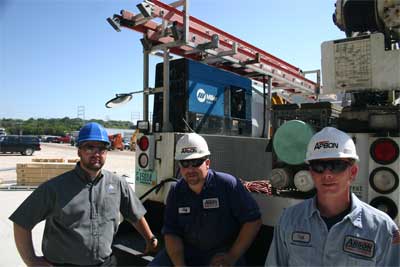 |
From L to R, Matt Walloch of Rite-Hite, Jeff Gruenewaldt and Ted Tetzlaff of Arbon take a break on the back of the F550 service truck.
|
Prepared for Any Challenge
Arbon’s ability to provide superior service and support stems from its dedicated fleet of 200 installation and service trucks. The trucks are typically Ford F-550s or Freightliner FL-50s, each of which is equipped with a Bobcat™ welding generator from Miller Electric Mfg. Co.
Installing loading dock equipment is challenging from one job site to another, and a prepared fleet is the key to a job well done and done on schedule. When an Arbon service truck rolls onto a construction site for a new plant or facility, electricity is usually not available. This happened to be the case at the new Palermo’s Pizza production and warehouse facility being built in Milwaukee.
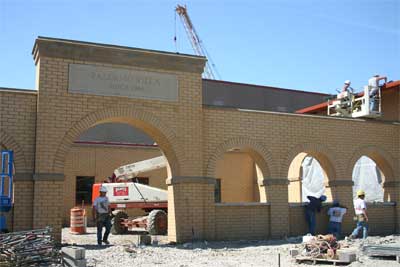 |
The front façade of the 250,000 square foot Palermo’s Pizza facility being built in Milwaukee, Wis.
|
The 135,000-sq.-ft. facility had 10 loading docks that Arbon was outfitting with Rite-Hite vertical hydraulic levelers for semi-trailers that will ship millions of pizzas. The lack of electricity didn’t pose a problem for Arbon technicians, as the Bobcat welding generators provide an Accu-Rated™ 10,500 watts of continuous power and 225 or 250 amps of welding power (depending on whether a Bobcat 225 or Bobcat 250 is used).
“To install and service doors and dock levelers*, we need welding power to run a 1/8-in. E7018 Stick electrode and generator power to run 11/16-in hammer-drills, impact wrenches and grinders,” says Ted Tetzlaff, technical team leader, Arbon. “The Bobcat enables us to run everything we need.”
* For installation details, see the “Arbon on the Job” section at the end of this story.
Reliability a Requirement
With the majority of construction time in the upper Midwest concentrated in the warmer months (“Summer in Wisconsin is two weeks of bad sledding” goes the old area joke), equipment reliability is extremely important. The same thing holds true for service work, as the customers typically need damaged loading docks back up and running quickly.
“If we don’t have a working welder on our trucks, we’re not able to take care of customer needs,” says Mark Coons, district service manager, Arbon. “We chose the Bobcats because of their reliability and their duty cycle. Whether its 100 degrees or 10 degrees below zero, they let us work all day without an issue.”
In addition to its F-550 and FL-50 trucks, Arbon also has some smaller service trucks, such as the F-350. Arbon outfits these trucks with Miller’s Blue Star 145® gas engine drive. At 263 lbs. (half the weight of a Bobcat) and with a smaller footprint, the Blue Star frees truck capacity for carrying additional service parts or equipment. The Blue Star provides 145 amps of welding power and 4500 watts of generator power.
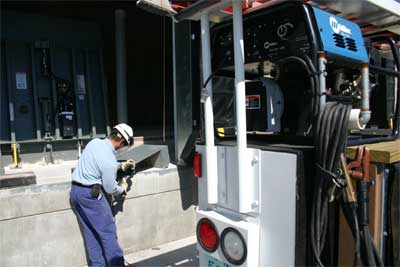 |
The Miller Blue Star 145 seen here, allows service technicians to run a number of hand tools such as this grinder. The weight and space savings of the Blue Star gives technicians the advantage to include more repair parts on their truck.
|
Planning for Uptime
Prior to becoming part of one of Arbon’s 60 branch offices nationwide, Tetzlaff belonged to an independent service company. This company’s service trucks had a mix of Miller and competitive welders in the field, as well as a spare welder at its regional shop that would be swapped out when a welder broke down in the field. This tactic, however, increased equipment and service costs, and it plans for failure.
Arbon, however, plans for success. For this reason, Arbon has now standardized on Miller welding generators for all its service trucks and instituted a preventive maintenance (PM) designed to increase equipment longevity and prevent downtime. Using just one brand of welding generator makes service training easier, and it reduces parts count.
Each Arbon service technician or vehicle operator is responsible for the preventive maintenance of their truck and the equipment it carries. Operators carry a card that informs them what type of scheduled maintenance is required and when it needs to be performed. The card covers everything from oil changes to alignments and tuning. To help with maintenance, most welding generators have an easy-to-read hour meter on the front panel. The newest Bobcat, introduced August 2006, has a meter that displays engine hours, oil change interval and (on diesel models only) high coolant temperature, low oil pressure shutdown and low fuel shutdown.
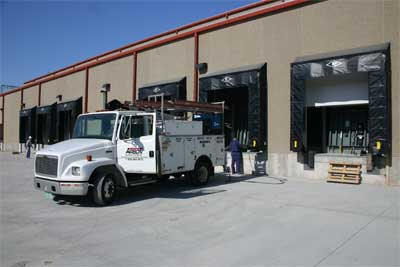 |
Arbon Equipment has a fleet of over 200 installation and service trucks. The Ford F550 seen here was ordered direct from the OEM with a service body, crane and Bobcat 250 welding generator from Miller Electric.
|
A good PM program (see the “Inside the Story” chart) enables Arbon to keep welding generator uptime close to 100 percent. In addition to scheduled activities, service technicians and vehicle operators keep an eye out for little problems (such as worn weld cables and ground clamps, the corrosive effects of road salt) and address them before they bloom into downtime-causing problems.
Fully Enclosed for Better Protection
Arbon is gradually replacing its older Bobcat 225 engine drives with the new Bobcat 250 model. The Bobcat 225 costs a few hundred dollars less than the Bobcat 250, but it does not have some of the added durability features of the Bobcat 250. These include a fully enclosed case that better protects the engine from impact damage (extremely common on service trucks) and from the elements, as well as a front panel fuel gauge. Considering the hourly cost of a service truck and its crew, preventing just one downtime incident can make up the extra cost of a Bobcat 250.
“The fully-enclosed welders are nice because they are more durable,” says Coons. “Even when we’re not welding with them, welding generators, take a beating just driving down the road because in Wisconsin, equipment gets exposed to the salt and road grime. Anytime you can cover the welder or keep it cleaner, you’ll be better off.”
For help selecting a twin-cylinder welding generator for your service truck, visit MillerWelds.com/truck. For information on all Miller welding generators, visit MillerWelds.com/products/enginedriven.
Arbon on the Job
Located a half-mile down the road from Milwaukee’s Miller Park stadium, the new Palermo’s Pizza warehouse was framed out and ready for the dock installations. Arbon installed a Rite-Hite Vertical Storing Hydraulic Leveler (VHL) for each of the 10 loading docks on the warehouse end of the facility. A VHL is a ramp that is lowered hydraulically from a vertical position within a warehouse onto the back of a docked semi-trailer. Rite-Hite’s vertical storing design increases security and climate control allowing the overhead door to remain closed and tight with the floor when not in use (this is especially important in the food industry, as a tight seal prevents insects, rodents and other “contaminants” from entering a building).Trucks can back up to the dock and get into position with trailer doors closed, which also protect the contents. Once in position, the facility door is opened and the leveler is lowered for loading and unloading.
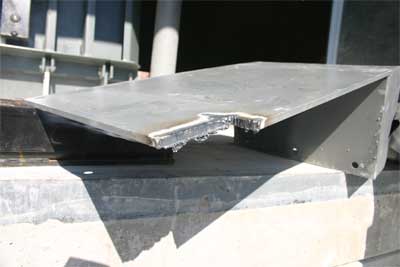 |
This is what the installed Rite-Hite Vertical Hydraulic Leveler looks like in its stored position.
|
Each VHL weighs approximately 2,000 lbs. After being lowered into place for installation with the truck-mounted crane, the VHL is welded to 1/4 in. mild steel anchor plates in the dock. The weld on this plate supports the pressures exerted upon it by the clevis (main hydraulic cylinder).
 |
Each Vertical Hydraulic Lift weighs approximately 2,000 lbs. After being lowered into position it is welded to the 1/4 in. mild steel anchor plates in the dock. The weld on this plate supports the pressures exerted upon it by the clevis (main hydraulic cylinder).
|
Next, docking bumpers are welded to mounting brackets. The bumpers protect the building from trailers backing into the loading dock.The brackets are also 1/4 in. thick mild steel and powder-coated with anti-corrosive paint. During the Palermo Pizza installation, Arbon technicians discovered that an electrical conduit coming out of the dock right where the bumper brackets were to be installed. This didn’t pose a problem, as the smaller service truck had a Smith Dual Guard Oxy-Acetylene Torch. Cutting a single notch in the bracket provided enough clearance for the conduit and kept the bumper aligned properly. Somewhat typical at this jobsite, electrical conduit sometimes appears in unexpected locations, prompting slight modifications.
Rite-Hite also offers Vehicle Restraint Systems designed to secure the trailer to the docking bay. Here, the installation requires a stress test. A typical weld on a vehicle restraint is subject to a minimum 30,000 pounds of pull force.